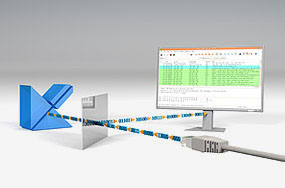Berlin, May 26th, 2021
Passthrough and Mirroring – Taking Real-Time Monitoring to the Next Level

Taking a closer look at data traffic is always worth it. Monitoring real-time data communication is even mandatory when it comes to the development of demanding real-time applications. In case of Windows real time as Kithara RealTime Suite provides it (real-time system isolated from Windows), Windows does not have direct access to the data flow between real-time environment and hardware. For this purpose, virtual Ethernet interfaces can be implemented, with which Windows applications such as Wireshark are able to log, monitor and analyze data.
Previously, Kithara RealTime Suite created such virtual interfaces in the real-time context by using Windows' own NDIS (Network Device Interface Specification). From now on however, virtual devices are generated by employing UDE (USB Device Emulation) introduced with Windows 10, allowing for communication of non-USB hardware with higher layers. This function of the new Network PTM Extension (Pass-through and Mirroring) can create virtual USB-Ethernet adapters in order to make the real-time data communication available to Windows by using port passthrough or port mirroring.
Passthrough passes data through the virtual interface, allowing Windows to communicate with the hardware or directly with the Kithara real-time environment. Mirroring makes a copy of the real-time data traffic at the port of the virtual switch and sends it to Windows for monitoring purposes. The possibility to display relevant data traffic in Windows, makes this extension a valuable development tool for efficient debugging and analysis.
For now, all Ethernet-based technologies supported by Kithara RealTime Suite can benefit from this function, namely socket communication, EtherCAT, GigE Vision, PTP and BroadR-Reach. However, the same mechanisms could be used in the future for efficient monitoring of other protocols as well.
